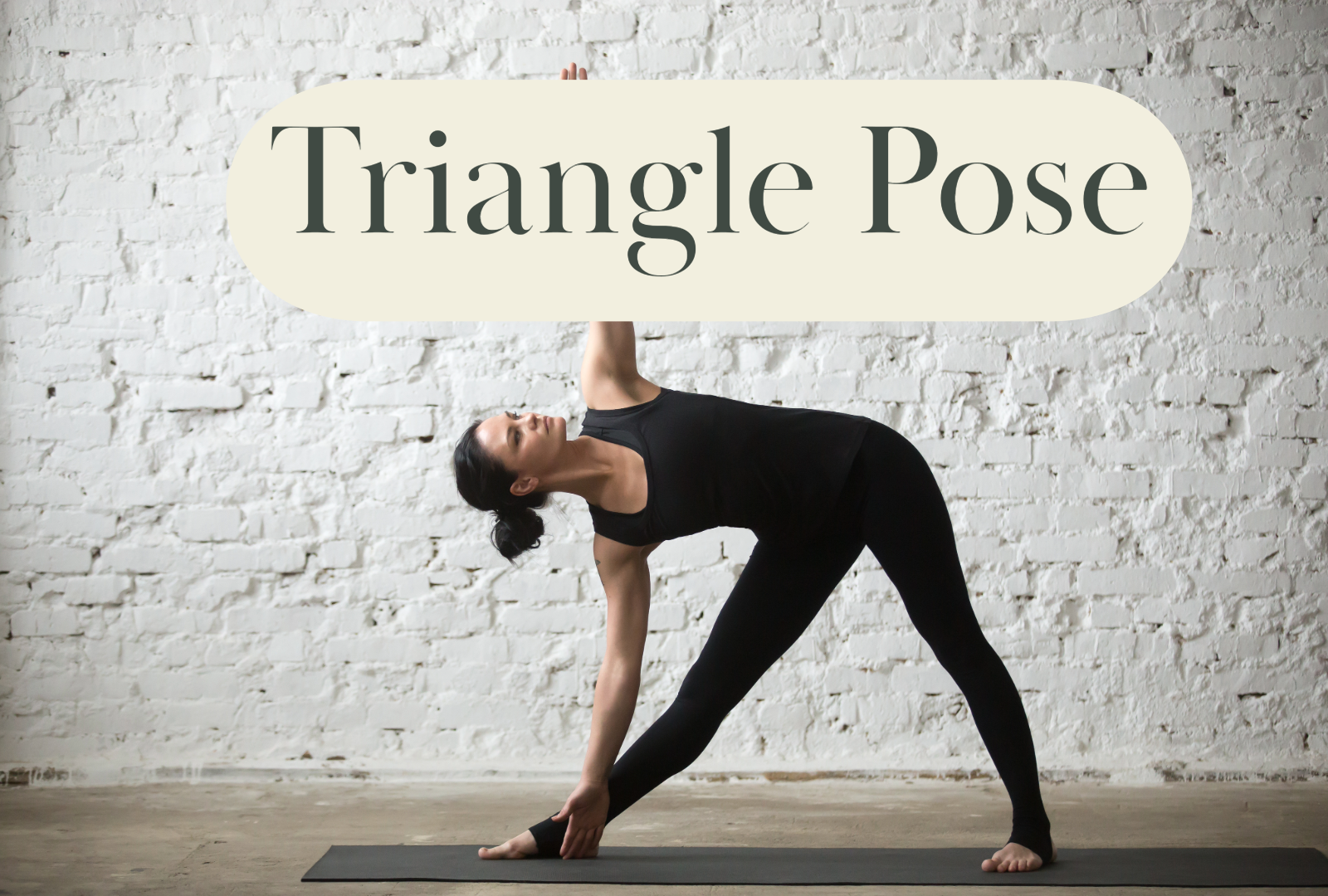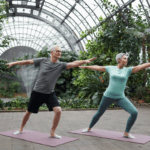Coming Soon: E-book about Kundalini Yoga - Sign up here to be among the first to get it!
Sanskrit: Trikonasana
Type: Standing Pose
Chakra Involved: Heart Chakra (Anahata Chakra), Sacral Chakra (Swadisthana Chakra), Root Chakra (Muladhara Chakra)

Triangle Pose (Trikonasana)
Triangle Pose, or Trikonasana, is a classic yoga posture known for its multitude of benefits, including stretching the legs, muscles around the knee, ankles, hips, groin area, hamstrings, calves, shoulders, chest, and spine. It also strengthens the muscles around the knee, thighs, and ankles, while improving digestion and stimulating all the abdominal organs. This pose is celebrated for its ability to provide both a challenge and a sense of openness, offering a unique balance of strength, flexibility, stability, and energizing the body.
Starting Position
Begin standing at the top of your mat in Mountain Pose (Tadasana), with your feet together and arms by your sides. Take a moment to ground your feet firmly into the mat, engaging your leg muscles and drawing your belly slightly in.
Step-by-step Instruction
- Step Feet Apart: Step or jump your feet about 3 to 4 feet apart, raising your arms to the sides so they are parallel to the floor, palms facing down. Ensure your feet are aligned and your legs are straight.
- Turn Your Feet: Turn your right foot out 90 degrees, so your toes point to the top of the mat. Pivot your left foot slightly inwards. Align the heel of your right foot with the arch of your left foot.
- Engage Your Legs: Firm your thighs and turn your right thigh outward, so the center of the right knee cap is in line with the center of the right ankle.
- Extend and Lower: Extend your torso to the right, directly over the right leg, bending from the hip joint, not the waist. Lower your right hand down to your ankle, shin, or the floor outside your right foot. Stretch your left arm toward the ceiling, in line with the tops of your shoulders. Keep your head in a neutral position or turn it to gaze up at your left hand.
- Open Your Torso: Press your outer left hip slightly forward and lengthen your tailbone toward your back heel. Look up at your left hand, but if this strains your neck, look straight ahead or down at the floor.
- Hold the Pose: Stay in this pose for 30 seconds to 1 minute, breathing deeply. Maintain the length of your spine and the openness of your torso.
To Release the Pose
- Come Up: Inhale deeply, pressing your back foot firmly into the floor and reaching the top arm toward the ceiling to lift your torso back to a standing position.
- Feet Position: Pivot your feet to the opposite direction and repeat Trikonasana on the other side to maintain balance in the body.
Teacher’s Tip
- Hip Alignment: Encourage students to keep their hips open and in line with the front of the mat. This helps deepen the stretch and maintain balance.
- Use Props: Suggest using a block under the lower hand for those who cannot comfortably reach the floor. This assists in maintaining alignment and provides support.
- Focus on Expansion: Remind students to think about expanding through the chest and stretching the spine, rather than how far they can reach down. This promotes a more beneficial and safer practice.
- Breath and Movement: Teach students to use their breath to find ease and depth in the pose, inhaling to create space and exhaling to deepen into the stretch.
Triangle Pose is a powerful posture that embodies the essence of stretching and strengthening, making it a cornerstone in many yoga practices.
Variations of Triangle Pose (Trikonasana)
Triangle Pose, or Trikonasana, offers various modifications and variations to accommodate different levels of practice, emphasize different aspects of the stretch, or target specific areas for strength and flexibility. Here are some common variations along with instructions for each:
1. Triangle Pose with a Block
- Instructions: Place a yoga block on the outside of your front ankle. As you fold into Trikonasana, rest your bottom hand on the block instead of reaching for the floor. This helps maintain alignment and provides support, making the pose more accessible for beginners or those with limited flexibility.
2. Revolved Triangle Pose (Parivrtta Trikonasana)
- Instructions: From Trikonasana, bring your top hand to your hip, and square your hips to the front of your mat. Place your opposite hand (from the foot that’s in front) on the outside of your front foot or on a block. Extend your other arm towards the ceiling, opening your chest for a revolved variation. This pose challenges balance and increases the spinal twist.
3. Bounded Triangle Pose (Baddha Trikonasana)
- Instructions: In the traditional Triangle Pose, reach your top arm behind your back and your bottom arm under your front leg. Attempt to clasp your hands or use a strap to hold onto. This variation intensifies the shoulder and chest opening and deepens the twist.
4. Extended Triangle Pose
- Instructions: From Trikonasana, instead of placing your bottom hand on the floor or a block, extend it toward the front of your mat, parallel to the floor. This increases the challenge to your balance and further strengthens the legs and core.
5. Triangle Pose with Chair
- Instructions: Place a chair on the outside of your front foot. As you fold into Trikonasana, rest your bottom hand on the seat of the chair. This is particularly helpful for those who find it difficult to reach the floor or a block, providing stability and support.
6. Floating Triangle Pose
- Instructions: Perform Trikonasana as usual, but instead of placing your bottom hand on your shin, ankle, or the floor, hover it a few inches above your leg. This variation requires and builds additional core strength and stability.
7. Triangle Pose with Gaze Variation
- Instructions: In the traditional Trikonasana pose, experiment with your gaze to challenge your balance and concentration. You can look down at your front foot, straight ahead, or up at your top hand, depending on what feels most comfortable for your neck and helps you maintain balance.
Implementation Tips
- Warm-Up: Ensure adequate warm-up of the body, particularly the legs and spine, before attempting these variations.
- Use Props: Encourage the use of props like blocks, straps, or chairs to make variations more accessible and comfortable.
- Listen to Your Body: Remind students to listen to their bodies and choose the variation that best suits their needs, avoiding any strain or discomfort.
- Focus on Alignment: Regardless of the variation, maintain the emphasis on alignment—especially keeping the spine long and the chest open.
Exploring these variations of Triangle Pose can deepen a practitioner’s experience of the pose, offering new challenges and insights while catering to a wide range of abilities and goals.
FAQs about Triangle Pose
Triangle Pose is renowned for enhancing flexibility, particularly in the legs, hips, and spine, while also opening up the chest and shoulders. This contributes to improved posture and facilitates deeper breathing. On a mental level, Trikonasana can help in alleviating stress, offering a sense of release as you extend and open your body.
Benefits of Triangle Pose:
- Flexibility: Enhances flexibility in the hips, thighs, and spine.
- Posture: Promotes improved posture through chest and shoulder opening.
- Stress Relief: Offers mental benefits such as stress and tension reduction.
- Circulation: Improves blood flow, particularly in the pelvic and abdominal regions.
For those new to Triangle Pose, the approach is straightforward yet requires attention to detail.
Instructions for Beginners:
- Position: Stand with feet about a leg-length apart, right foot turned out 90 degrees, left foot in slightly.
- Alignment: Extend arms to the sides, then hinge at the right hip to extend torso to the right, placing right hand on shin or the floor.
- Final Pose: Extend left arm upwards, keeping legs straight, and gaze up at the left hand.
The challenge of Triangle Pose often lies in its demand for simultaneous stretching, balancing, and twisting. It requires flexibility in the hamstrings, strength in the legs, an open chest for deep breathing, and a stable core for balance. For those with tight muscles or less strength in these areas, the pose can be particularly challenging. To summarise we can say that Triangle pose is demanding due to the following:
- Flexibility Requirement: Requires significant hamstring flexibility and open hips.
- Strength Requirement: Demands leg and core strength for balance and support.
- Complexity: The simultaneous actions of stretching, balancing, and twisting can be difficult to coordinate.
Pyramid Pose (Parsvottanasana) and Triangle Pose differ primarily in their stance and orientation. In Pyramid Pose, the feet are aligned one in front of the other, with the body folding forward over the front leg. In contrast, Triangle Pose involves a wide stance with the body tilting sideways, keeping the legs straight and the arms extending perpendicular to the floor.
In Triangle Pose, the legs are intended to remain straight to maximize the stretch along the hamstrings and to strengthen the thighs. However, it’s important to avoid locking the knees; a micro-bend can help maintain stability without putting undue pressure on the joints.
Triangle Pose engages a wide range of muscles, including the hamstrings, thighs, and muscles along the spine. It strengthens the legs and core, stretches the shoulders and chest, and when turning the head upwards, also engages the neck muscles. This pose offers a comprehensive workout that supports both strength and flexibility.
- Primary Muscles: Hamstrings, thighs, and spinal muscles.
- Secondary Muscles: Shoulders, chest, and neck muscles during the twist and arm extension.
Individuals with low blood pressure, severe balance issues, or significant neck, back, hip, or knee injuries should approach Triangle Pose with caution or avoid it altogether. It’s crucial to listen to your body and consult with a healthcare provider if you’re unsure about performing this pose, especially if you have existing health concerns.
- Low Blood Pressure: Individuals with low blood pressure should be cautious, as the pose can cause dizziness.
- Injuries: Those with recent or significant neck, back, hip, or knee injuries should avoid or modify the pose.
- Balance Issues: Severe balance issues may make the pose unsafe without proper support.




